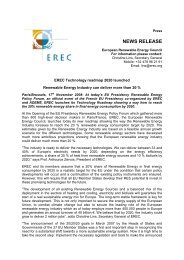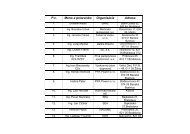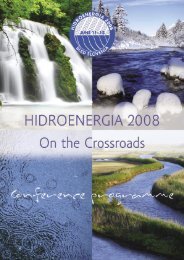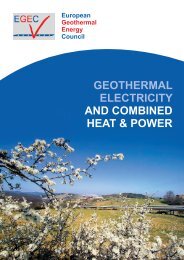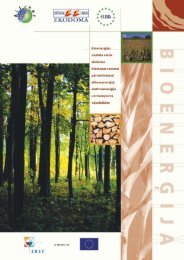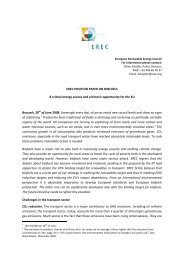CTO Assessment - European Commission
CTO Assessment - European Commission
CTO Assessment - European Commission
You also want an ePaper? Increase the reach of your titles
YUMPU automatically turns print PDFs into web optimized ePapers that Google loves.
LAUSANNE<br />
Solar City<br />
Contact : Pierre-Pascal Favre •Ville de Lausanne – Direction des Services industriels,<br />
service gaz & cad• Pl. Chauderon 25 • CP 836• 1000 Lausanne • Switzerland<br />
Email: pierre-pascal.favre@lausanne.ch • Tel: +41 21 315 87 10<br />
Website: www.lausanne.ch/energie<br />
The city of Lausanne in Switzerland and its<br />
Utilities (SIL) has already received international<br />
recognition and several prizes, among<br />
which the <strong>European</strong> Solar Prize, for the city’s<br />
major effort in developing RES. City’s activities<br />
aim to develop PV: among others a 570<br />
m 2 surface of solar panels was installed on a<br />
city Sport stadium. Other activities are in<br />
the area of solar thermal, biomass and district<br />
heating systems (DHS).<br />
The Initiative<br />
Lausanne has for some time been committed<br />
to an annual investment to guarantee a minimum<br />
installation of 10 kWp PV capacity.<br />
This program stopped in 2000 and was replaced<br />
by a «solar stock exchange».<br />
The broad PV activities encompass the installation<br />
of a PV roof on the sport stadium.<br />
Hence, the 65 kWp solar generator occupies<br />
a surface of 570 m 2 , composed of 1.296<br />
panels. The electricity current is re-injected<br />
after having been transformed into AC of<br />
220 volts.<br />
Another project offered the possibility to citizens<br />
to buy a solar kit, largely subsidized by<br />
the city to reach the price of 550 Swiss francs<br />
(about 350 euros). This campaign introduced<br />
in 1999 has had so much success that there<br />
were no solar kits available any more.<br />
More than 400 m 2 of solar thermal panels<br />
have been installed by the Lausanne Utilities<br />
on residential buildings property of the City<br />
of Lausanne.<br />
Other activities include RES when making<br />
urban planning. For instance, the SIL pushes<br />
to integrate biomass DHS instead of choosing<br />
a cheaper but unclean option. The investment<br />
is minimal for the owners, but is transferred<br />
to the cost of the people renting the<br />
houses.<br />
Overall Evaluation:<br />
The overall RES approach has been very<br />
successful, partly because it has been able<br />
to approach citizens by giving them readyfor-use<br />
products (the solar kits), and partly<br />
because one of the most symbolic place of<br />
the city, the Pontaise stadium, has become<br />
a symbol for an innovative and clean approach<br />
to energy supply of a city.<br />
Main innovative aspects<br />
Subsidies on photovoltaics range between<br />
1,000 and 2,000 CHF (640–1,300 euros)<br />
according to the installed peak power of the<br />
PV plant.<br />
Lausanne utilities also introduced in 1997 a<br />
local tax of 0.025 CHF/kWh (0.016 EUR/<br />
kWh) on the increase of the annual consumption<br />
of electricity. The amount of money in the<br />
so-created fund is thus directly proportional<br />
to the variation of the Lausanne’s annual consumption<br />
and can only be used for investments<br />
made in the renewable energy for electricity<br />
production (hydro excluded!) and energy efficiency<br />
for electrical appliances sectors.<br />
Enabling factors<br />
The fact that Lausanne developed this original<br />
fund combined with the influence of a<br />
strong Green party and a charismatic person<br />
representing the party have played a major<br />
role by influencing energy efficiency and renewable<br />
energy projects.<br />
Innovation<br />
Photovoltaics<br />
Solar thermal<br />
Biomass DHS<br />
plant<br />
Overall RES<br />
increase<br />
Creation of<br />
jobs<br />
Challenges<br />
The introduction of a tax is a sensitive issue:<br />
only an increase in energy consumption will<br />
lead to further investments in RES, whereas<br />
RES and EE efforts should ideally go together.<br />
The push for houses to be connected to a biomass<br />
DHS is also a delicate step: All the cost<br />
is reported onto the renters, a majority in<br />
Switzerland, without having given them the<br />
choice to do so.<br />
Replication Potential<br />
Inspired by the example of the PV stadium of<br />
Lausanne, another PV stadium was inaugurated<br />
in 2002 in Basel (Switzerland). Several<br />
regions of Switzerland have also finalized their<br />
interest in PV kits and bought 400 of them.<br />
Environmental targets<br />
A good example of concerted approach between<br />
the regional authority dealing with<br />
transport emissions, and the electricity utility<br />
dealing with electricity and heat emission in<br />
houses is, for instance, in the case where a big<br />
supermarket is planned in the periphery of the<br />
city, because this generates many traffic emissions,<br />
the electricity utility pushes to convince<br />
the legislative power to declare the obligation<br />
to connect the building zone to DHS.<br />
Installation of a PV roof on the sport stadium for a surface of 570 m 2 ,<br />
for 1,296 panels; more than 400 m 2 of solar thermal panels installed by<br />
the SIL on residential buildings property of the City of Lausanne.<br />
17 installations PV plants have been installed and are owned by the<br />
Services Industriels de Lausanne (SIL) for a capacity of 190 kWp<br />
8 PV installations for 234 kWp are in private ownership but under the<br />
contract of SIL in the framework of the Solar programme (bourse<br />
solaire); three electrical boats (each powered by 3.5 kWp of PV, are<br />
operational on the lake of Geneva for tourists). The proportion of PV<br />
represents 0.02%.<br />
The total m 2 surface of solar thermal integrally covers the yearly<br />
consumption of hot water for 200 people<br />
The DHS is powered by the waste burning plant, the wasted water<br />
treatment plant and a wood-fired plant<br />
Still a very low % compared to large hydropower and nuclear power<br />
Small local enterprises active in PV have been able to survive and<br />
are well established by now, thanks to the mandates of the SIL<br />
<strong>CTO</strong> - Showcase<br />
77



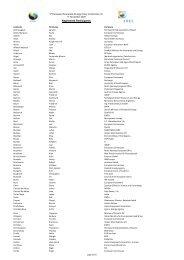
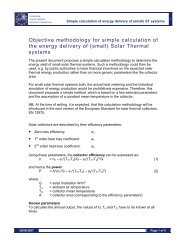
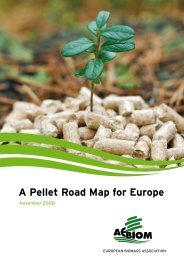
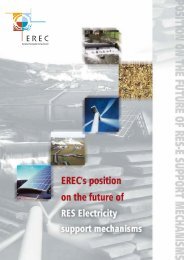

![Energy [R]evolution - Greenpeace](https://img.yumpu.com/47174859/1/184x260/energy-revolution-greenpeace.jpg?quality=85)
